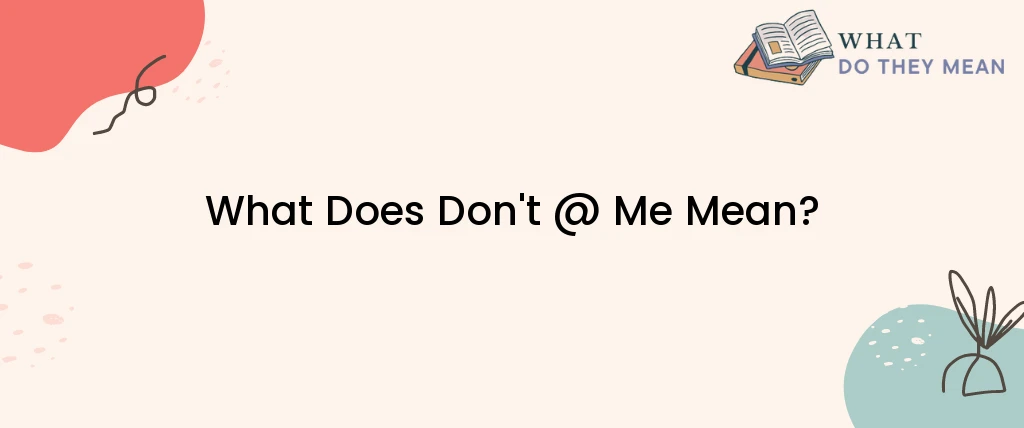The phrase “Don’t @ me” is commonly used to request that the person speaking not be mentioned or tagged in a post, comment, or message. With the rise of social media and the ease of communication it provides, people can easily share their thoughts and opinions with a wide audience. However, this has also led to an increase in debates, arguments, and online harassment. “Don’t @ me” is a phrase that has gained popularity in recent years as a way to end or avoid such conversations.
What does “@ me” mean?
To understand “Don’t @ me,” we need to first understand what the “@” symbol means in the context of social media. When you tag or mention someone on a platform such as Twitter, Facebook, or Instagram using the “@” symbol, that person will receive a notification that they have been mentioned in a post or comment. This is often used to direct a message to a specific person or to include them in a conversation.
What does “Don’t @ me” mean?
“Don’t @ me” is a phrase that is used to tell someone not to include or tag the speaker in a post, comment, or message. It is often used in response to a controversial or opinionated statement that the speaker has made, indicating that they don’t want to engage in a debate or argument about their opinion. In essence, it means “Don’t involve me in this discussion or debate.”
Origin of “Don’t @ me”
The origin of “Don’t @ me” can be traced back to the early days of Twitter, when the “@” symbol was used to mention someone in a post. At the time, users would often use the phrase “Don’t @ me” to express their disinterest in being mentioned or included in certain conversations. It was a way to protect themselves from harassment or unwanted attention, and to set boundaries for their online interactions.
Over time, the phrase gained popularity and became a part of the social media lexicon. Today, it is used on a variety of platforms, including Twitter, Facebook, and Instagram.
Usage of “Don’t @ me”
“Don’t @ me” is typically used in response to a statement or opinion that the speaker has shared. It is a way for the speaker to express their desire to not engage in further conversation or debate about the topic. Here are some examples of how “Don’t @ me” can be used in different contexts:
- “I think pineapple belongs on pizza. Don’t @ me.” (The speaker is sharing their opinion but indicating that they don’t want to hear any arguments against it.)
- “I don’t really care about the Super Bowl. Don’t @ me.” (The speaker is expressing their disinterest in the topic and doesn’t want to be included in any discussions about it.)
- “I prefer Android phones over iPhones. Don’t @ me.” (The speaker is stating their preference and doesn’t want to be involved in any debates about the merits of each type of phone.)
In some cases, “Don’t @ me” can be used as a warning or threat, especially in online arguments or debates. It can be a way to signal that the speaker is not interested in continuing the conversation and that any further attempts to engage them will not be productive.
Alternatives to “Don’t @ me”
While “Don’t @ me” is a popular phrase, it’s not always the most effective way to express disinterest or to set boundaries online. Here are some alternative phrases that can be used in different situations:
- “I’m not interested in discussing this further.” (This is a more direct and assertive way to express disinterest in a topic.)
- “Let’s agree to disagree.” (This is a way to acknowledge a difference in opinion without continuing to argue about it.)
- “I respect your opinion, but I don’t agree with it.” (This is a way to show that you’re not interested in engaging in an argument while still acknowledging the other person’s viewpoint.)
- “I’m going to step back from this conversation now.” (This is a way to indicate that you’re disengaging from a discussion without being confrontational.)
Conclusion
“Don’t @ me” is a popular phrase that is often used on social media to express disinterest in a topic or to avoid online arguments and debates. It has its origins in the early days of Twitter and has since become a part of the social media lexicon. While it can be a useful way to set boundaries and protect oneself from unwanted attention, it’s important to remember that there are alternative phrases and strategies that can be used to express disinterest or disagreement without being confrontational or dismissive.

As a researcher, I am curious and driven by the pursuit of knowledge. I approach my work with a critical eye, carefully evaluating sources and methods to ensure that my findings are accurate and reliable. Whether delving into scientific studies, historical records, or cutting-edge technologies, I am always seeking to expand my understanding and make new discoveries. I am dedicated to uncovering new insights and finding solutions to complex problems, and am driven by a passion for uncovering the truth.



